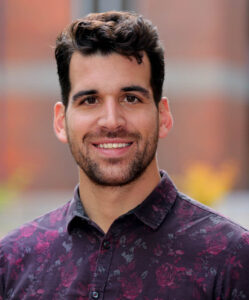“Excellence Unveiled at UNC with Chancellor Lee Roberts” is a series on 97.9 The Hill and Chapelboro.com sponsored by the University of North Carolina at Chapel Hill. Each episode shines a light on members of the Carolina community and the outstanding work they do. Listen to the full episode below, or read the complete transcript.
In the twelfth installment of “Excellence Unveiled,” Frank Leibfarth, Royce Murray Distinguished term Professor of Chemistry, speaking on the importance of making plastic waste easier to reuse and removing PFAS from drinking water — and the work UNC’s chemistry department does to advance our understanding of the world around us, and how we thrive within it.
My laboratory thinks a lot about the challenge of the huge quantities of plastic waste we produce as a society every day. And, typically, if you throw plastic into the recycling bin, it goes to a recycling center, it gets sorted, and then what actually happens to it is it gets what we call downcycled. So downcycling is the idea that plastic is used for a application that is less valuable than the application it was originally used for. So, what my lab wants to do is turn this paradigm on its head and do what we call upcycling.
So, the idea of upcycling is that you transform that plastic through chemistry into a new material that’s actually more valuable than the material that it began with. One way we’ve exemplified this is we took what would be typically considered like a milk jug, so polyethylene, and we turn that into a material that is one of the main materials used in the production of golf balls.
And we hope that this idea of upcycling can create an economic incentive for recycling. Most of the plastics that we interact with every day are one of two materials both made from petroleum: polyethylene and polypropylene. You know polyethylene as the plastic bag you get at the grocery store, polypropylene as a yogurt container. So, those two plastics correspond to 55% of all the plastics made in the world, and they’re typically very challenging to recycle or upcycle because they’re made of these very inert chemical bonds, carbon and hydrogen. So typically thinking about doing chemistry on something as simple as carbon and hydrogen is really difficult. But that’s where my lab steps in, in collaboration with the lab of Professor Eric Alexanian, and also at UNC Chapel Hill. What we’re trying to do is blend a lot of the lessons from pharmaceutical chemistry and medicinal chemistry and actually apply that to plastic waste where we can actually react those typically inert carbon-hydrogen bonds to add new chemical functionality, which gives the plastic new function.
One of the problems my lab has recently become interested in is removal of forever chemicals, otherwise known as PFAS, from water. And this is a particular challenge, especially in eastern North Carolina where the formerly DuPont plant, now Chemours plant, has polluted a lot of the water that runs in the Cape Fear River to Wilmington, North Carolina. And the unique thing about this project is we got inspired to work on it because of the citizens in the state of North Carolina demanding a solution.
I’ve come to call this kind of more community-focused basic research, and I think it’s a really interesting model that, in collaboration with the legislature and this organization housed at UNC Chapel Hill called the NC Collaboratory, have really pioneered and it’s unique in the nation.
We’ve had the opportunity to make new materials, scale them up to a pilot manufacturing scale, and actually test those materials in municipal water utilities.
In North Carolina, what we sought to develop was a resin or a material that specifically takes forever chemicals out of water and doesn’t get inhibited by all the other organic matter that’s in water. So, what typically happens with most filtration technologies is they get saturated or clogged by all that organic matter and the PFAS sneaks through. What my lab sought to do through development of chemistry is to develop chemistries that would go on a material that could selectively grab that PFAS, even in the presence of all that organic matter. And what that looks like in practice, is that looks like beads that are packed into columns. Those columns could be anything from the filter in your fridge or your Brita pitcher, all the way up to the scale of a municipal water treatment plant that treats water for an entire town. A note for me, I’m really proud to be at a public university where our mission really is to serve the people of the state.


